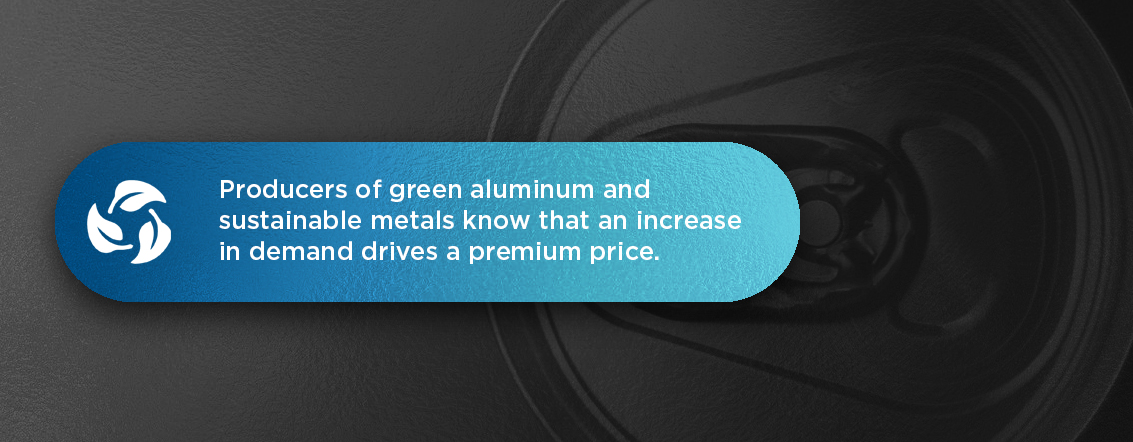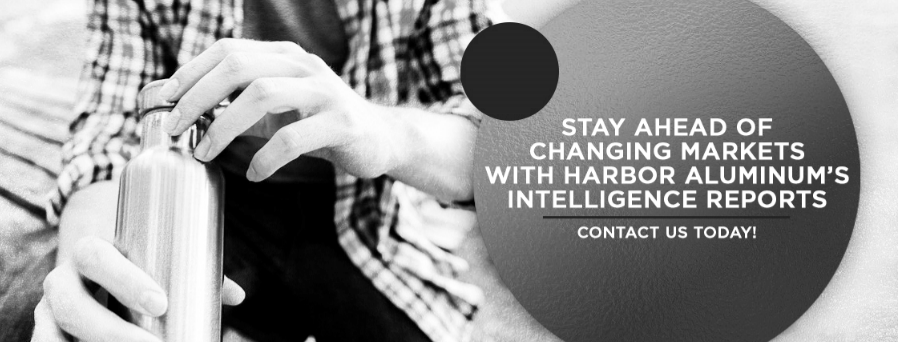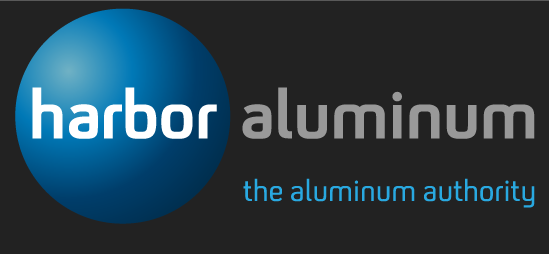Green Aluminum: The Sustainable Metal
Aluminum is a strong and lightweight commodity, contributing billions of dollars to the global economy and supporting countless supply chains worldwide. But like all manufactured products today, aluminum is facing increased scrutiny due to its energy-intensive production and refinement processes that are said to contribute significantly to global carbon emissions.
In response to being put under the climate microscope, primary aluminum producers worldwide are adopting new environmentally friendly production processes, including shifting towards the use of renewable energy, and investing in new green smelting technologies (like inert anode) or even studying carbon capture and storage solutions to accelerate their decarbonization efforts. However, across the entire aluminum industry, investing in recycling has currently become the preferred initiative to reduced carbon emissions in the production process.
Green primary aluminum is in increasing demand, and, as a result, aluminum products branded as “low-carbon” or “green” are starting to charge a premium price.
Learn More About Green Aluminum Consulting
What Is Green Aluminum and Why the Shift?
The global aluminum market is in considerable expansion, expected to reach a value of $86.5 billion by 2025. The growth is attributed to ongoing demand increases in several key markets, including in the auto, beverage, construction, and electrical market. Aluminum can production is expected to increase thanks to a growing trend of canned wine and spirits as well as cold-brew coffees, natural sweetener sodas and other popular beverages.
With an increase in aluminum production expected, there’s growing concern over the CO2 emissions that will result in larger carbon footprints. Aluminum and metal production, in general, has traditionally been considered a contributor to global pollution, with its leading power source coming from coal.
Consumers and investors alike are placing increasing pressure on a range of industries declared to be energy-intensive. Manufacturers are now being encouraged, if not obligated, to source their materials responsibly or to shift their processes to more sustainable ones. Aluminum production is no exception, with green aluminum being the industry’s response to these concerns.
Environmentally friendly aluminum is considered “green,” “super-green” or “ultra-green” primarily due to its production power source or proportion of recycled content. When aluminum producers rely primarily on a renewable energy source to produce the metal, it can be considered Green Aluminum. Much of North America’s aluminum is produced using hydroelectricity. Also known as “hydropower,” hydroelectricity is produced by converting the kinetic energy from rushing water into mechanical energy, which is then converted into electricity.
According to the International Aluminum Institute, the power supply mix of aluminum production is shifting. While 50% of the world’s aluminum is still made using coal power, 39% is now made using hydropower. By comparison, in non-aluminum global manufacturing, hydropower only accounts for 15% of the power supply mix.
In North America, over 83% of aluminum production in 2018 was powered by hydroelectricity compared to just 55% in 2008. Alcoa is a primary aluminum producer in North America, with 70% of its smelters being hydro-powered, a target they hope to increase to 85%.
According to the Canadian Mines and Minerals Plan, Canada produces some of the “greenest aluminum in the world,” with one Rio Tinto smelter in British Columbia having reduced its total greenhouse gas emissions by 36% thanks to the combination of hydropower and new green smelting technology that replaced older, more carbon-intensive technology.
There are other factors that experts consider when determining the sustainability of aluminum. First, it’s a highly recyclable material, with almost 75% of all aluminum produced in the U.S. still being used today. Second, it’s extremely lightweight compared to other metals, meaning it’s more efficient to transport, and vehicles made of aluminum consume less fuel.
Forming a Green Aluminum Market
Based on HARBOR’s green aluminum research reports, we can confirm that the low-carbon or green aluminum market is indeed taking off. According to Bloomberg analysts, the growing demand for green aluminum and the recent investment in green technology is driving the possible creation of an entirely separate premium trading market for green aluminum alone. The pressure on aluminum manufacturers to meet climate protection goals and move toward net-zero carbon (or carbon neutral) is so significant that it is causing commodity trading markets to respond.
Producers of green aluminum and sustainable metals know that an increase in demand drives a premium price. That’s why many producers have begun rebranding their low-carbon products to demonstrate the value their green aluminum offers. Rio Tinto has launched its RenewAl product, while Alcoa has released an entire product line called Sustana, which features its Ecolum low-carbon product.

Launching Green aluminum brands is gaining momentum, as it increases brand awareness and leadership perception and seems needed to get a potential Green Upcharge. Additional Green/Low-Carbon Aluminum brands out in the market include: Reduxa by Norsk Hydro, Allow by Rusal, CelestiAl by EGA, NaturAl by Century, and Restora by Vedanta. Super Green Aluminum brands (metal with high recycled content; mainly post-consumer) include Norsk Hydro’s Circal, among others.
While neither manufacturer will state exactly how much of a premium its environmentally friendly aluminum is commanding, executives from both companies say that their low-carbon products are subject to supply and demand like any other good. Green aluminum is necessary, and buyers will undoubtedly pay extra for its increased value. In fact, wire rod currently commands the highest premiums due to its use in power wiring linked to the green energy transition around the world.
The Demand for Green Aluminum
The demand for green primary aluminum is only in its infancy. Manufacturers are continuing to set environmental responsibility goals targeting their supply chain. In industries that rely heavily on aluminum supply, aluminum products branded as green or low-carbon will become more and more appealing.
Industries like consumer electronics, auto manufacturing, roof window manufacturing, and consumer packaged goods are looking for ways to keep their products low-carbon so they can meet government regulations as well as the standards set by their consumers and investors. Global industries like these that rely on aluminum are putting pressure on the producers to shift towards a more sustainable production process.
The automotive industry began its “Drive Sustainability” campaign that would see major automotive makers join to commit to more green production processes. The sourcing of green aluminum has been a key strategy in meeting these objectives. Recently, Hydro partnered with Mercedes-Benz to supply low-carbon aluminium to reduce the carbon footprint of their vehicle fleet; Rio Tinto and Ford Motor Company signed a MoU to jointly develop more sustainable and secure supply chains for battery and low-carbon materials to be used in Ford vehicles; Alcoa had previously supplied sustainable aluminum to RONAL GROUP for the wheels on Audi vehicles.
Apple is in a similar position. Looking to reduce the carbon footprint of its supply chain, the company recently laid out a $10 million investment in a partnership between Alcoa and Rio Tinto to establish an aluminum production facility in Quebec, Canada. Called Elysis, the production facility is set to use a low-carbon technology to produce the aluminum alloy Apple needs for its iPhones. The green technology used at the joint production facility is expected to cut carbon emissions drastically.
Specially-marked low carbon beverage can have been launched in Canada using aluminium from Rio Tinto and leveraging ELYSIS technology. In Japan, 100% recycled aluminum cans have been produced by UACJ with collaboration of Toyo Seikan; these cans are reported to have a carbon footprint 60% lower than traditional 350 ml cans.
On the building and construction side, VELUX , a roof window manufacturer, has partnered with Norsk Hydro to manufacture green aluminum products and halve its carbon emissions by 2030.
Using low-carbon and recycled aluminium in new office buildings and developments will enhance the sustainability credentials in the building and construction sector.
Stay Ahead of Changing Markets With HARBOR Aluminum’s Intelligence Reports
With the growing demand for aluminum worldwide and the increased need to meet environmental benchmarks, green aluminum is becoming a viable investment, commanding a premium price.
To help facilitate the demand for green aluminum, HARBOR Aluminum Intelligence has launched the world’s first green aluminum premium assessments:
-
US MW P1020 Green Aluminum Spot Premium
-
Rotterdam Duty-paid P1020 Spot Green/Low-Carbon Aluminum Upcharge
-
European Full Billet Spot Green/Low-Carbon Aluminum Upcharge
-
European Full Billet Quarterly Green/Low-Carbon Aluminum Upcharge
-
European Primary Foundry Alloy (A356.2) Annual Green/Low-Carbon Aluminum Upcharge
-
European Slab (1XXX, 3XXX, and 5XXX series) Annual Green/Low-Carbon Aluminum Upcharge
-
European EC Rod Annual Green/Low-Carbon Aluminum Upcharge
-
US PFA (A356.2) Spot Green/Low-Carbon Aluminum Upcharge
-
US PFA (A356.2) Annual Green/Low-Carbon Aluminum Upcharge
-
US Billet 6063 Spot Green/Low-Carbon Aluminum Upcharge
-
US Billet 6063 Annual Green/Low-Carbon Aluminum Upcharge
-
US Slab (1XXX, 3XXX, and 5XXX series) Annual Green/Low-Carbon Aluminum Upcharge
To find the latest market developments on Green Aluminum product supply, demand, investments, expansions, initiatives, trade, carbon pricing, public policies, and accurate green aluminum reports and a sample of the green aluminum premium, contact HARBOR Aluminum today.

